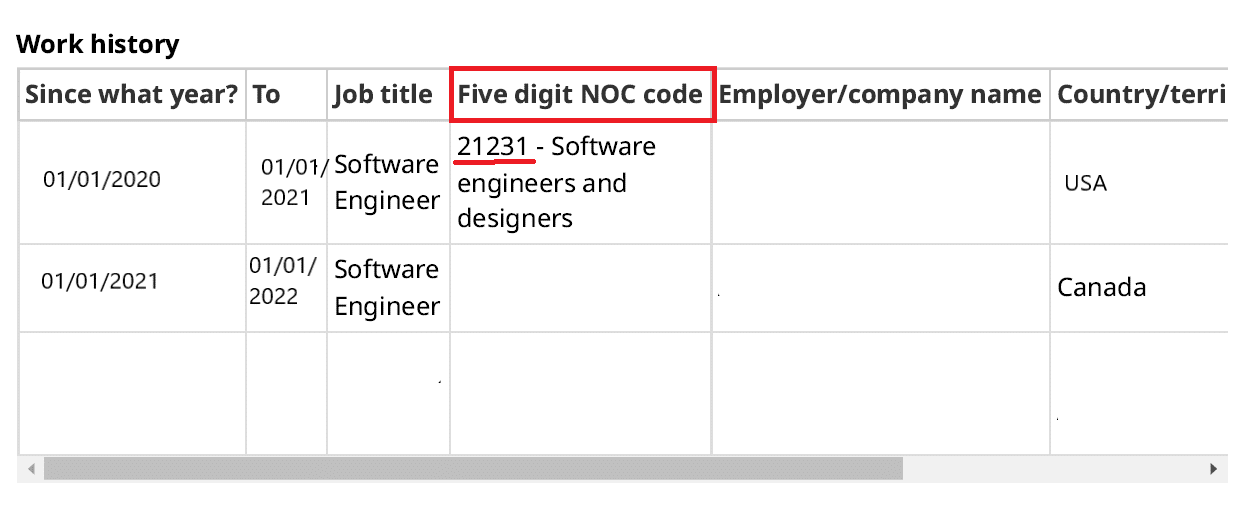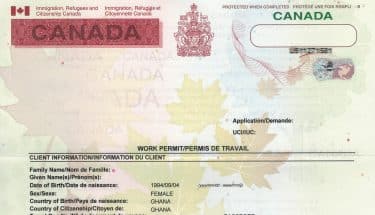UPDATE: Transition to National Occupational Classification (NOC) 2021
If you currently have a profile in the Express Entry pool, then you received an email yesterday advising of the change from NOC 2016 to NOC 2021. With the changes from November 16, 2022, candidates in the Express Entry pool will not be eligible to receive an ITA until their profile is updated with the NEW NOC 2021 code, also known as TEER. The ITA rounds may resume as soon as at 23 November 2022 and everyone who has a profile in the EE pool needs to update their profile with the new 5-digit TEER code as soon as possible. If you already received an invitation to apply (ITA) before November 16, 2022 you must submit your application using the old (2016) NOC code.
If you have already submitted a profile but have not been sent an ITA you must update your profile with your new TEER Category and 5-digit occupation code. You can search for your occupation under NOC 2021 list on this website https://noc.esdc.gc.ca/?GoCTemplateCulture=en-CA .
On November 16, 2022 IRCC switched to the 2021 version of the National Occupational Classification (NOC). The 2016 NOC skill type and skill level structure (NOC 0, A, B, C and D) will be replaced by a 6-category system representing the training, education, experience and responsibilities needed to work in an occupation in Canada. The National Occupational Classification (NOC) is updated every few years based on information received from Statistics Canada. The new NOC 2021 contains 516 occupations, up from the 500 unit groups included in the NOC 2016.
The new updated program means that:
The current NOC 2016 skill type and skill level structure (NOC 0, A, B, C and D) will be replaced with a 6-category system representing the training, education, experience and responsibilities (TEER) needed to work in an occupation
· 4-digit occupation codes will become 5-digit codes
· the eligibility criteria for all programs that use the NOC will be further updated
If you are a Provincial Nominee Program (PNP) candidate your NOC version will depend on when the province received your application.
Here is what the employment history looked like with the NOC 2016

Here is how it looks now in an Express Entry profile with the new updated NOC 2021 code:

Next Steps – How To Update Your Profile to TEER (2021 NOC)
Login to your Express Entry profile and change the four digit NOC code to the five digit TEER code according to your job.
You also have to modify the NOC code in the dropdown – even though the title still says “four digit NOC code”, you MUST update to the five digit format. When you make the change, the code will automatically appear as a five digit number with the occupation you selected.
The previous version is still in place and looks like this:

Here is how the new NOC 2021 TEER code should look:

Classifying jobs
The new 2021 National Occupational Classification NOC system is used to classify jobs (occupations) into training, education, experience and responsibilities TEER categories which are based as the one from 2016 on the type of:
- job duties
- the type of work a person does
The program will impact all of these Canadian immigration applications:
- Canadian Experience Class
- Federal Skilled Workers
- Federal Skilled Trades
- Out-of-status construction workers
- Other economic classes (non-Express Entry)
Updated Express Entry Eligibility Requirements
These programs will have updated eligibility requirements because of the change to NOC 2021:
Permanent Residence
- Express Entry
- Federal Skilled Worker Program
- Canadian Experience Class
- Federal Skilled Trades Program
- Atlantic Immigration Program
- Provincial Nominee Program
- Caregiver programs
- Rural and Northern Immigration Pilot
- Agri-Food Pilot
Temporary Status (Work Permits)
- Out-of-status construction workers
- International Mobility Program
- Temporary Foreign Worker Program
New NOC 2021 TEER Categories
Programs that used the NOC skill type or levels in the 2016 NOC are now updated and will use TEER categories from the NOC 2021 system.
|
NOC 2016 |
NOC 2021 TEER |
| Skill type 0 | TEER 0 |
| Skill level A | TEER 1 |
| Skill level B | TEER 2 and TEER 3 |
| Skill level C | TEER 4 |
| Skill level D | TEER 5 |
Most jobs will stay in the TEER category that is equal to the skill level in the table. Some jobs may change to a different TEER category.
Skill level B jobs may become either TEER 2 or TEER 3 jobs.
Find your occupation under the NOC 2021 list to find out what TEER category it belongs to.
Additional instructions related to NOC 2021 will be provided for remaining economic permanent residence applications at a later date which has not yet been released by IRCC.
Summary of Changes – NOC 2016 to NOC 2021 TEER
The biggest change is the replacement of skill levels with the Training, Education, Experience and Responsibilities (TEER) categories which is more precise because NOC now assesses the level of training a person has, formal education of experience required to gain entry into each occupation, and the responsibilities associated to it. The old NOC assessed the level of skills which was not as precise as the new updated NOC.
The second major change revolves around the number of TEER categories which the new one consist of. In the new NOC structure of 2021, there are six TEER categories, up from the current four skill levels. In the 2016 version of the NOC, “skill level” B contains the most occupations of all skill levels (about 1/3 of all unit groups) and its employment requirements are relatively wide. This change ensures clearer distinctions between the employment requirements associated with each TEER category, leading to a more consistent and homogeneous classification.
The new TEER categories are outlined here:
| TEER 0 | Management occupations. |
| TEER 1 | Completion of a university degree (bachelor’s, master’s or doctorate); or
Several years of experience in a specific occupation from TEER category 2 (when applicable). |
| TEER 2 | Completion of a post-secondary education program of two to three years at community college, institute of technology or CÉGEP; or
Completion of an apprenticeship training program of two to five years; or Occupations with supervisory or significant safety (police officers and firefighters) responsibilities; or Several years of experience in a specific occupation from TEER category 3 (when applicable). |
| TEER 3 | Completion of a post-secondary education program of less than two years at community college, institute of technology or CÉGEP; or
Apprenticeship training of less than 2 years; or More than six months of on-the-job training, training courses or specific work experience with some secondary school education; or Several years of experience in a specific occupation from TEER category 4 (when applicable). |
| TEER 4 | Completion of secondary school; or
Several weeks of on-the-job training with some secondary school education; or Several years of experience in a specific occupation from TEER category 5 (when applicable). |
| TEER 5 | Short work demonstration and no formal educational requirements. |
The third major change is the classification system which is moved from a four tiered to a five tiered system and changed from the traditional 4-digit format to a new 5-digit format which is more flexible and allows many new unit groups as needed in the future.
The new NOC 2021 led to a number of changes to the occupations themselves according to ongoing changes in the Canadian labour market. New unit groups were created for emerging occupations such as Data scientists and cybersecurity specialists and some were granted their own unit group such as Financial advisors and Police investigators, and the three distinct unit groups created for Software developers and programmers. The information sector, health and agriculture sector as well as postal service and military occupations also were renewed.
About the National Occupation Classification (NOC)
The National Occupational Classification (NOC) is the national reference for occupations in Canada which provides a classification structure that categorizes occupations for labour market information employment-related program administration. This type of information of an utmost importance for the labour market and people who want to work in Canada. This system is used by immigration services to decide if a job or type of work experience meets their eligibility. The basic principle is the kind of work performed and jobs are grouped with this principle on the work someone does this being determined by the tasks, duties, employment requirements, and responsibilities associated with each occupation.
What is an occupation?
An occupation is defined as a collection of jobs that are sufficiently similar in work performed to be grouped under a common label for classification purposes. A job, in turn, encompasses all the tasks carried out by a particular worker to complete their duties. The NOC comprises about 30,000 job titles gathered into 500 unit groups, organized according to four skill levels and ten broad occupational categories. Unit groups are based on similarity of skills, defined primarily by functions and employment requirements.
NOC classification criteria
As classification criteria is used the occupation and skill level. Other factors may be also taken in consideration like occupational mobility and industrial sector.
Broad occupational category: Represents the type of work performed, the field of study, or the industry of employment whenever industry-specific work experience is required for entry into occupation. The first digit of a NOC code represents the broad occupational category.
Skill level: Represents a broad aggregation of education, training, and work experience and also takes into account the complexity of the tasks and responsibilities associated with the job. The second digit of a NOC code represents the skill level.
TEER categories and examples of jobs
You can view the full list of occupation classifications under NOC 2021 on the ESDC site. Choose “NOC 2021” from the drop-down menu to search for your occupation.
Contact us if you have questions about the new NOC 2021 TEER system and how it impacts your Express Entry profile and PR application.




